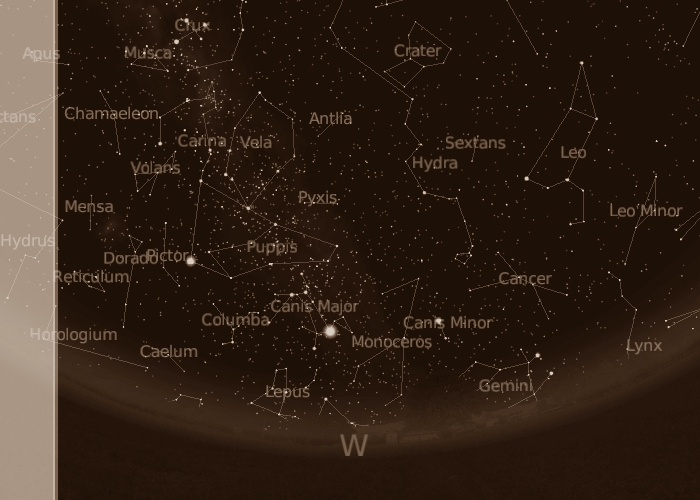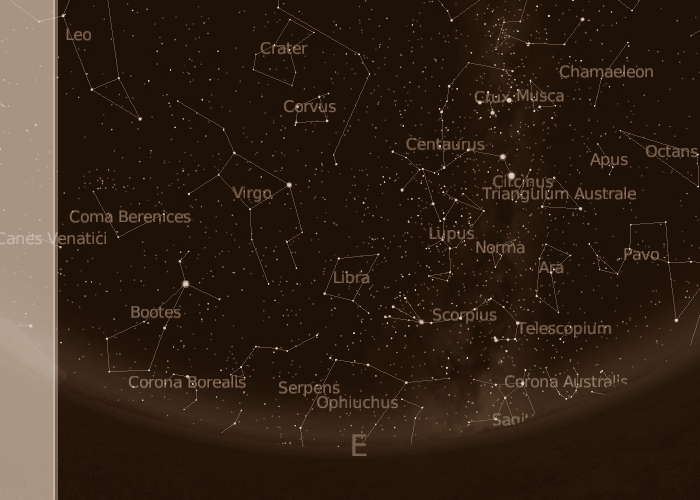Western Horizon
Eastern Horizon
Precisions About Daylight Saving Time (DST) Adjustments
![]()
Western Horizon
Eastern Horizon
Precisions About Daylight Saving Time (DST) Adjustments
->You will note that our site is passing to DST for the northern hemisphere this month as it back to ST in the southern hemisphere! more details
->Vous noterez que notre site passe à l'heure d'été ce mois, pour l'hémisphère nord. Il passe à l'heure d'hiver pour l'hémisphère sud. plus de détails

We're in fall now! The sky, South, in fall, it's that large band of Milky Way-embedded, typically southern constellations, which are spanning a great width, over South, from Sagittarius, the Archer to Canis Major, the Great Dog. A much fine show, probably with no equivalent elsewhere in the world. The Sagittarius remains low now, as scorpius, the Scorpion is already well risen. A fine show! Lupus, the Wolf, is hereafter as the two bright stars, high, are the famed 'Pointers'. Those both stars -Alpha Centauri and Agena- are called this way as their alignment allows to spot Crux, the Southern Cross. Let's procede there. A fine show! See how Crux is, in turn, allowing to see where the northern celestial pole is, which is lying about 30° above the horizon, due South. Let's keep on westwards! Now, it's those three constellations which had been born, in the 18th century, from the parting of the antique, vast constellation of Argo, the Ship, this ship of the Argonauts, those Greek heroes which left for their quest of the Golden Fleece. Canis Major, the Great Dog, at last, with Sirius, is ending all those beauties! That's not all however! The show is complemented by both the Magellanic Clouds as such other marvels, like Omega Centauri (NGC 5139), this famed, 3.7th magnitude globular cluster or 47 Tucanae, another globular cluster, are to be found too in that part of the sky. Various typical southern constellations, which are not seen during the reminder of the year, are seen too, South, like Apus, the Bird of Paradise, Volans, the Flying Fish, or Octans, the Octant. A part of Hydra, the Hydra, West, is seen, along with Cancer, the Crab -where M44 is to be found, this famed open cluster, Praesepe, the Beehive, as the other bright star in the neighbourhood is Procyon, of Canis Minor, the Little Dog. to a printer-friendly chart
West for the tropics. West for the mid-northern latitudes

Let's turn East, now! A large part of the southeastern part of the sky is filled with the left part of the band of Milky Way-embedded, typically southern constellations, that we saw with the western sky. One of the serpents of Ophiuchus, the Serpent Holder is seen East, as Libra, the Scales, is above. The two bright stars, northeast, high, are Arcturus and Spica, respectively. Arcturus is part of Bootes, the Herdsman, as Spica of Virgo, the Virgin. Virgo is home to deep-sky galaxy fields, along with Coma Berenices, the Berenice's Hair. Due North, you'll find a plain view for Leo, the Lion. Leo Minor, the Little Lion is available too. The lucky ones who will get a completely plain horizon, will be able to spot stars of the Big Dipper, which are just lying on the horizon. A much fine, and rare show! to a printer-friendly chart
East for the tropics. East for the mid-northern latitudes
Some countries in the southern hemisphere don't have any Daylight Saving Time system. Some do have one. According to the policy of our site, our sky charts include a one-hour DST shift for the period September to March. Should your DST period differ, just adjust the charts. Should you not have any DST, take in account that one-hour DST shift we are applying September-March
For more details upon whether you country is applying, and when, a DST, please check a search engine on the Internet, for example!
Website Manager: G. Guichard, site 'Amateur Astronomy,' http://stars5.6te.net. Page Editor: G. Guichard. last edited: 12/28/2010. contact us at ggwebsites@outlook.com